Our staffs: Names in Blue, Our students: Names in Red.
Original Papers
- Tetsu Yonezawa, Takashi Asano, Mai Thanh Nguyen
“Desorption and Ionization of Amino Acid Compounds Observed by Negative Ion Mode Surface-Assisted Laser Desorption/Ionization Mass Spectrometry (SALDI-MS) using Titanium Oxide Nanoparticles”
Nano Biomedicine, in press.Abstract: Surface-assisted laser desorption / ionization mass spectroscopy (SALDI-MS) in negative mode of various amino acids with commercial TiO2 nanoparticles as the DI assisting material is reported. SALDI-MS gives clear spectra of these low molecular weight negative ions, such as drugs and bio-related organic compounds. With commercially available TiO2 nanoparticles, 20 common amino acids used could be clearly detected as [M-H]– molecular ions. The ion intensity of [M-H]– molecular ions is well linear correlated with the gas-phase acidity but less correlation with the hydrophobicity. But the concentration of the amino acids on the TiO2 nanoparticle surface also affected the ion intensity.
- Yuen-ting Rachel Chau, Hsin-hui Huang, Mai Thanh Nguyen, Koji Hatanaka, and Tetsu Yonezawa
“THz wave emission from Cu2O/Cu interface under femtosecond laser irradiation”
Applied Physics Express (APEX), 14(1), 012006 (2021) (5 pp.).
DOI: 10.35848/1882-0786/abd070 (Published (web) 24 December 2020)Abstract: Cu or Cu/Au (80nm-thick Cu, 50nm-thick Au) sputtered on Si were kept at 25 °C for a week or annealed at temperature from 80 to 300 °C, then tested for THz emission under femtosecond laser irradiation (35 fs-800nm). THz radiation was detected from samples annealed from 80 to 170 °C, which had Cu2O/Cu interface as the THz source. Cu/Au/Si annealed at 80 °C emitted the highest THz radiation because of high laser absorption by the porous Cu2O layer formed at low temperature and the Au film reflected THz radiation and/or increased the laser absorption by Fabry–Pérot effect.
- Mai Thanh Nguyen, Krittaporn Wongrujipairoj, Hiroki Tsukamoto, Soorathep Kheawhom, Shuang Mei, Vipada Aupama, Tetsu Yonezawa
“Synergistic Effect of Oleic Acid and Oleylamine Mixed Liquid Matrix on Particle Size and Stability of Sputtered Metal Nanoparticles”
ACS Sustainable Chemistry & Engineering, 8(49), 18167-18176 (2020).
DOI: 10.1021/acssuschemeng.0c06549 (Published (web) 30 November 2020)
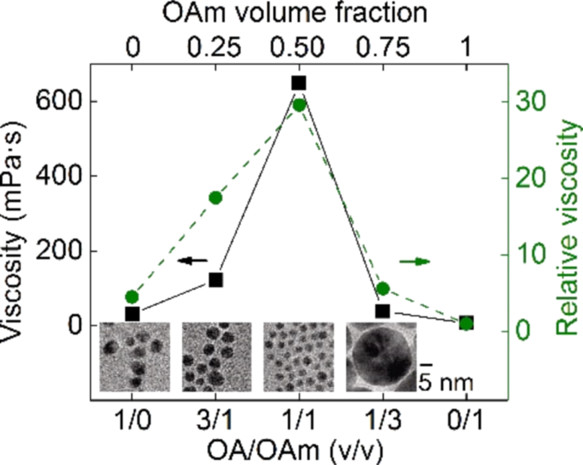
Abstract: This research investigates the impact of mixing oleylamine and oleic acid as a liquid matrix for sputtering of metal nanoparticles and the mixed-liquid composition on the particle size, uniformity, and their colloidal and oxidation stability. The case study was conducted for Au and Cu, which are noble and non-noble metals, respectively. The results reveal that the mixed liquids are more effective in producing smaller and more uniform metal nanoparticles. Smallest Au nanoparticles with highly colloidal stability over a year were obtained with an equal volume of OA and OAm. OA/OAm 1/1 (v/v) also exhibited the best protection effect from oxidation for Cu nanoparticles. The results can be attributed to the improved viscosity and synergistic protecting capability of the mixed liquids compared with the single-component liquids.
Cover Picture
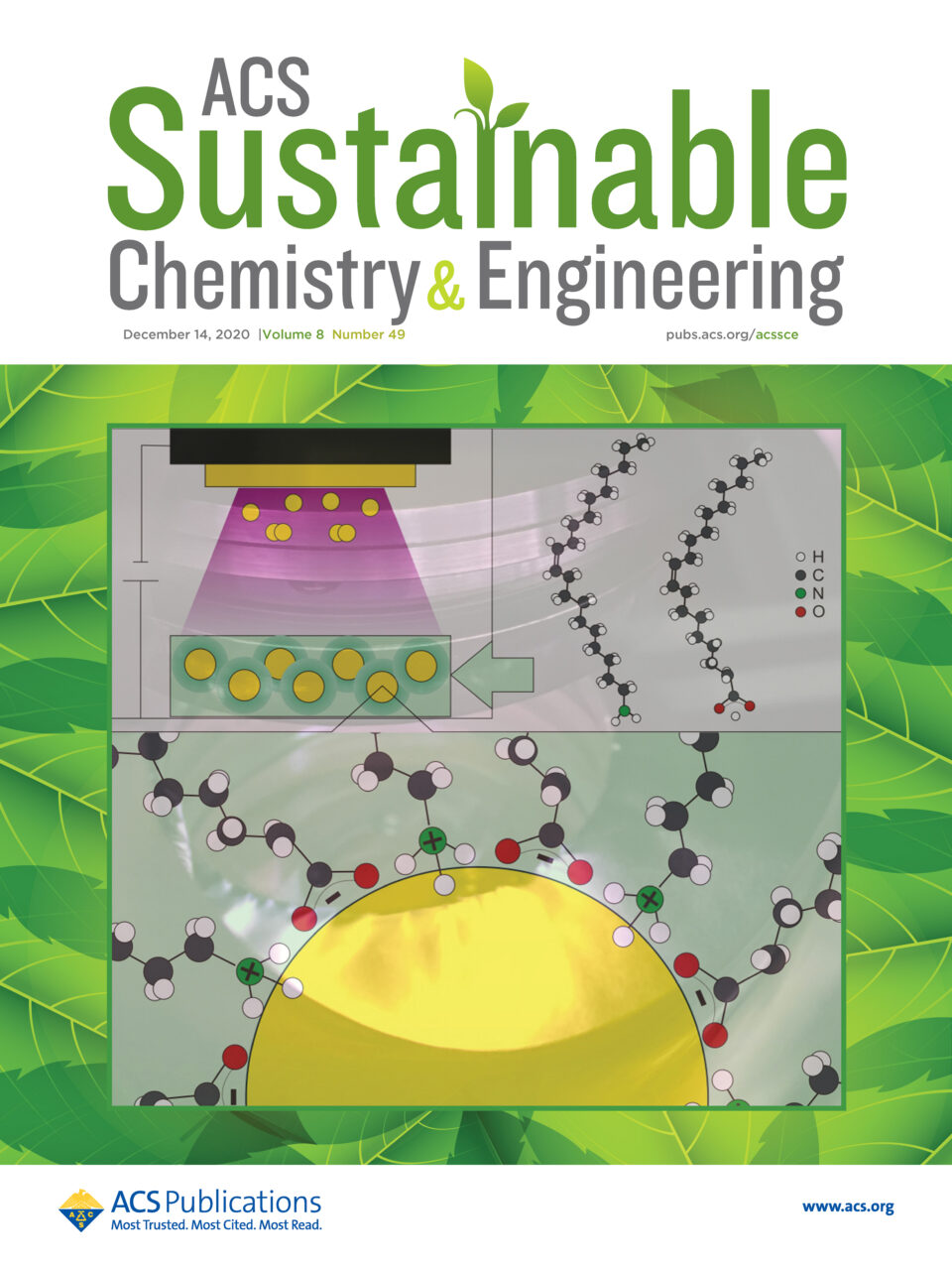
- Shuai Liu, Rintaro Tokura, Mai Thanh Nguyen, Hiroki Tsukamoto, Tetsu Yonezawa
”Surfactant-stabilized Copper Paticles for Low-temperature Sintering: Paste Preparation using a Milling with Small Zirconia Beads: Effect of Pre-treatment with the Disperse Medium”
Advanced Powder Technology, 31(11), 4570-4575 (2020).
DOI: 10.1016/j.apt.2020.10.004 (Published (web) 9 November 2020)
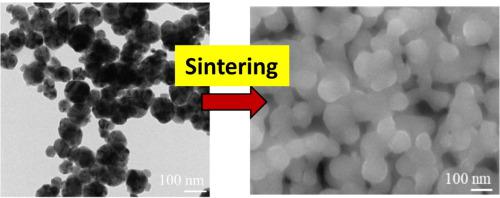
Abstract: Copper paste is considered as a promising candidate for printed electronics in replacement for silver paste. This is owing to copper which has anti-electromigration property, lower cost, and similar conductivity and compared with silver. We synthesize a copper nanoparticle (NP) paste that can be sintered at low temperature for high conductivity. The copper NP paste composes of 50 wt% copper NPs and dipropylene glycol (DPG) as the disperse medium. The effect of DPG coating and various conditions of milling with small beads on improving the dispersity of copper NPs has been investigated. The optimum conditions for milling are at 1000 and 2000 rpm for 30 min. This results in a volume resistivity of 6.62 × 10-6 Ω·cm after sintering the copper NP paste at 200 °C.
- Ikumi Akita, Yohei Ishida, Tetsu Yonezawa
“Distinctive Stability of Free-standing Monolayer Clay Mineral Nanosheet under Transmission Electron Microscopy”
Physical Chemistry Chemical Physics, 22, 25095-25102 (2020).
DOI: 10.1039/D0CP04659K (Published (web) 08 Oct 2020)
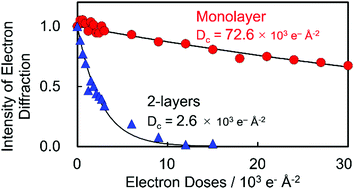
Abstract: Among 2D materials, clay mineral nanosheets have been extensively studied owing to their specific features, such as high surface charge and large surface area. Recently, we reported a stable free-standing (without any surfactants or matrices) monolayer clay mineral, characterized via annular dark-field scanning transmission electron microscopy (ADF-STEM) at the atomic-scale. Herein, we demonstrated that the monolayer clay mineral exhibited the outstanding stability under electron beam irradiation compared to two- or three-layered nanosheets via electron diffraction analysis. In addition to its low thickness (~1 nm-thick), the absence of an interlayer space was the critical factor contributed to the distinctive stability of the monolayer clay mineral, compared to that of the two- or three-layered clay mineral. The findings here inspire further investigation in free-standing clay mineral using (S)TEM and also for a wide variety of nanomaterials which are strongly hydrated.
- Ramin Khezri, Soraya Hosseini, Abhishek Lahiri, Shiva Rezaei Motlagh, Mai Thanh Nguyen, Tetsu Yonezawa, Soorathep Kheawhom
“Enhanced cycling performance of rechargeable zinc-air flow batteries using potassium persulfate as electrolyte additive”
International Journal of Molecular Sciences, 21(19), 7303 (2020).
DOI: 10.3390/ijms21197303 (Published 2 October 2020)【Open Access】Abstract: Zinc–air batteries (ZABs) offer high specific energy and low-cost production. However, rechargeable ZABs suffer from a limited cycle life. This paper reports that potassium persulfate (KPS) additive in an alkaline electrolyte can effectively enhance the performance and electrochemical characteristics of rechargeable zinc–air flow batteries (ZAFBs). Introducing redox additives into electrolytes is an effective approach to promote battery performance. With the addition of 450 ppm KPS, remarkable improvement in anodic currents corresponding to zinc (Zn) dissolution and limited passivation of the Zn surface is observed, thus indicating its strong effect on the redox reaction of Zn. Besides, the addition of 450 ppm KPS reduces the corrosion rate of Zn, enhances surface reactions and decreases the solution resistance. However, excess KPS (900 and 1350 ppm) has a negative effect on rechargeable ZAFBs, which leads to a shorter cycle life and poor cyclability. The rechargeable ZAFB, using 450 ppm KPS, exhibits a highly stable charge/discharge voltage for 800 cycles. Overall, KPS demonstrates great promise for the enhancement of the charge/discharge performance of rechargeable ZABs.
- Tanawat Phusittananan, Wathanyu Kao-Ian, Mai Thanh Nguyen, Tetsu Yonezawa, Rojana Pornprasertsuk, Ahmad Azmin Mohamad, Soorathep Kheawhom
“Ethylene glycol/Ethanol Anolyte for High Capacity Alkaline Aluminum-Air Battery with Dual Electrolyte Configuration”
Frontiers in Energy Research, 8, 189 (2020).
DOI: 10.3389/fenrg.2020.00189 (Published 31 July 2020) 【Open Access】Abstract: Aluminum-air batteries (AABs), due to their low cost and high specific capacity, receive much attention nowadays. Nonetheless, a vital problem curbing wide application of AABs is corrosion of the aluminum (Al) anode, which is triggered by hydrogen evolution reaction (HER). Therefore, this work tackles the problem of anode corrosion in an alkaline Al-air flow battery (AAFB) by implementing a dual-electrolyte system. The battery configuration consists of an Al anode | anolyte | anion exchange membrane | catholyte | air cathode. The anolytes in this work are ethylene glycol/ethanol solutions (0, 5, 10, 20, and 30%) v/v containing 3 M potassium hydroxide (KOH). A polymer gel electrolyte (Carbopol® 940) is employed as the catholyte. The corrosion of an Al electrode in the anolytes is duly examined. It is significant that when the ratio of ethylene glycol exceeds 5% v/v, this negatively affects the dissolution process and suppresses Al corrosion. Furthermore, the battery using the anolyte with 5% v/v ethylene glycol, at a discharge current density of 5 mA/cm2, demonstrates peak power of 3.75 mW/cm2. The battery also exhibits the highest specific discharge capacity of 2,100 mAh/gAl (70% utilization of Al) at a discharge current density of 2.5 mA/cm2. In general, the dual-electrolyte system affirms its effectiveness in controlling anodic corrosion, quelling passivation of the Al surface in the alkaline AABs and boosting discharge capacity. KOH in ethylene glycol/ethanol solution is a promising anolyte being more environmentally friendly, less toxic and providing favorable electrochemical performance.
- Sonti Khamsanga, Mai Thanh Nguyen, Tetsu Yonezawa, Patchanita Vatakul, Rojana Pornprasertsuk, Prasit Pattananuwat, Adisorn Tuantranont, Siwaruk Siwamogsatham, and Soorathep Kheawhom
“MnO2 Heterostructure on Carbon Nanotubes as Cathode Material for Aqueous Zinc-ion Batteries”
International Journal of Molecular Sciences, 21(13), 4589 (2020).
DOI:10.3390/ijms21134689 (Published 30 June 2020) 【Open Access】
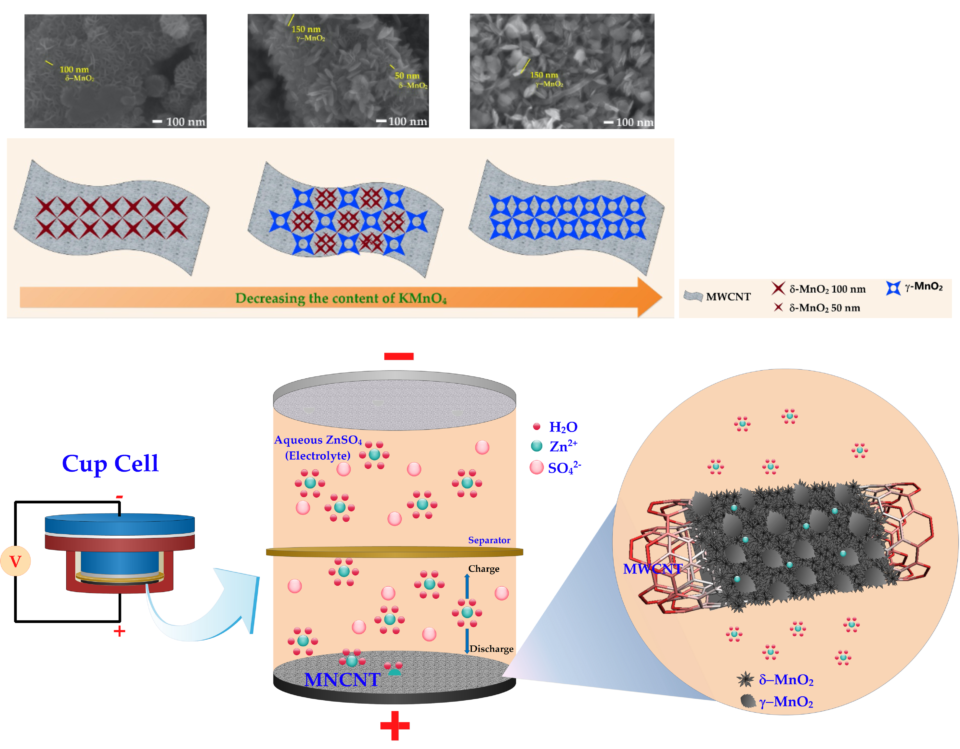
Abstract: Due to their cost effectiveness, high safety, and eco-friendliness, zinc-ion batteries (ZIBs) are receiving much attention nowadays. In the production of rechargeable ZIBs, the cathode plays an important role. Manganese oxide (MnO2) is considered the most promising and widely investigated intercalation cathode material. Nonetheless, MnO2 cathodes are subjected to challenging issues viz. limited capacity, low rate capability and poor cycling stability. It is seen that the MnO2 heterostructure can enable long-term cycling stability in different types of energy devices. Herein, a versatile chemical method for the preparation of MnO2 heterostructure on multi-walled carbon nanotubes (MNH-CNT) is reported. Besides, the synthesized MNH-CNT is composed of δ-MnO2 and γ-MnO2. A ZIB using the MNH-CNT cathode delivers a high initial discharge capacity of 236 mAh g−1 at 400 mA g−1, 108 mAh g−1 at 1600 mA g−1 and excellent cycling stability. A pseudocapacitive behavior investigation demonstrates fast zinc ion diffusion via a diffusion-controlled process with low capacitive contribution. Overall, the MNH-CNT cathode is seen to exhibit superior electrochemical performance. This work presents new opportunities for improving the discharge capacity and cycling stability of aqueous ZIBs.
- Pemika Teabnamang, Wathanyu Kao-ian, Mai Thanh Nguyen, Tetsu Yonezawa, Rongrong Cheacharoen, Soorathep Kheawhom
“High Capacity Dual-electrolyte Aluminum-air Battery with Circulating Methanol Anolyte”
Energies, 13(9), 2275 (2020).
DOI: 10.3390/en13092275 (Published 5 May 2020). 【Open Access】Abstract: Nevertheless, a critical issue limiting their practical application is corrosion of aluminum (Al) anode in an alkaline aqueous electrolyte, which results from hydrogen evolution reaction (HER). To effectively solve the corrosion issue, dissolution of Al anode should be carried out in a nonaqueous electrolyte. However, the main cathodic reaction, known as oxygen reduction reaction (ORR), is sluggish in such a nonaqueous electrolyte. A dual-electrolyte configuration with an anion exchange membrane separator allows AABs to implement a nonaqueous anolyte along with an aqueous catholyte. Thus, this work addresses the issue of anode corrosion in an alkaline Al–air flow battery via a dual-electrolyte system. The battery configuration consisted of an Al anode | anolyte | anion exchange membrane | catholyte | air cathode. The anolytes were methanol solutions containing 3 M potassium hydroxide (KOH) with different ratios of water. An aqueous polymer gel electrolyte was used as the catholyte. The corrosion of Al in the anolytes was duly investigated. The increase of water content in the anolyte reduced overpotential and exhibited faster anodic dissolution kinetics. This led to higher HER, along with a greater corrosion rate. The performance of the battery was also examined. At a discharge current density of 10 mA·cm−2, the battery using the anolyte without water exhibited the highest specific capacity of 2328 mAh/gAl, producing 78% utilization of Al. At a higher content of water, a higher discharge voltage was attained. However, due to greater HER, the specific capacity of the battery decreased. Besides, the circulation rate of the anolyte affected the performance of the battery. For instance, at a higher circulation rate, a higher discharge voltage was attained. Overall, the dual-electrolyte system proved to be an effective approach for suppressing anodic corrosion in an alkaline Al–air flow battery and enhancing discharge capacity.
- Ryan Dula Corpuz, Lyn Marie De Juan-Corpuz, Mai Thanh Nguyen, Tetsu Yonezawa, Heng-Liang Wu, Anongnat Somwangthanaroj, Soorathep Kheawhom
“Binder-Free α-MnO2 Nanowires on Carbon Cloth as Cathode Material for Zinc-ion Batteries”
International Journal of Molecular Sciences, 21(9), 3113 (2020). 【Open Access】
DOI: 10.3390/ijms21093113 (Published 28 April 2020)Abstract: Recently, rechargeable zinc-ion batteries (ZIBs) have gained a considerable amount of attention due to their high safety, low toxicity, abundance, and low cost. Traditionally, a composite manganese oxide (MnO2) and a conductive carbon having a polymeric binder are used as a positive electrode. In general, a binder is employed to bond all materials together and to prevent detachment and dissolution of the active materials. Herein, the synthesis of α-MnO2 nanowires on carbon cloth via a simple one-step hydrothermal process and its electrochemical performance, as a binder-free cathode in aqueous and nonaqueous-based ZIBs, is duly reported. Morphological and elemental analyses reveal a single crystal α-MnO2 having homogeneous nanowire morphology with preferential growth along {001}. It is significant that analysis of the electrochemical performance of the α-MnO2 nanowires demonstrates more stable capacity and superior cyclability in a dimethyl sulfoxide (DMSO) electrolyte ZIB than in an aqueous electrolyte system. This is because DMSO can prevent irreversible proton insertion as well as unfavorable dendritic zinc deposition. The application of the binder-free α-MnO2 nanowires cathode in DMSO can promote follow-up research on the high cyclability of ZIBs.
- Ikumi Akita, Yohei Ishida, and Tetsu Yonezawa
“Atomic-scale Imaging of a Free-standing Monolayer Clay Mineral Nanosheet using Scanning Transmission Electron Microscopy”
The Journal of Physical Chemistry Letters, 11(9), 3357-3361 (2020).
DOI:10.1021/acs.jpclett.0c00758 (Published (web) 5 April 2020)

Abstract: Although aberration-corrected scanning transmission electron microscope (STEM) enables the atomic-scale visualization of ultrathin 2D materials such as graphene, imaging of electron-beam sensitive 2D materials with structural complexity is an intricate problem. We here report the first atomic-scale imaging of a free-standing monolayer clay mineral nanosheet via the annular dark field (ADF) STEM. The monolayer clay nanosheet was stably observed under optimal conditions, and we confirmed that the hexagonal contrast pattern with a pore of ∼4 Å corresponds to the atomic structure of clay mineral that consisted of adjacent Si, Al, Mg, and O atoms by comparison with simulations. The findings offer the usefulness of ADF–STEM techniques for the atomic scale imaging of clay minerals and various 2D materials having electron-beam sensitivity and structural complexity than few-atom-thick graphene analogues.
- Shilei Zhu, Dan Deng, Mai Thanh Nguyen, Yuen-ting Rachel Chau, Cheng-Yen Wen, Tetsu Yonezawa
“Synthesis of Au@Cu2O Core-Shell Nanoparticles with Tunable Shell Thickness and Their Degradation”
Langmuir, 36(13), 3386-3392 (2020).
DOI: 10.1021/acs.langmuir.0c00382 (Published (web) 16 Mar 2020)
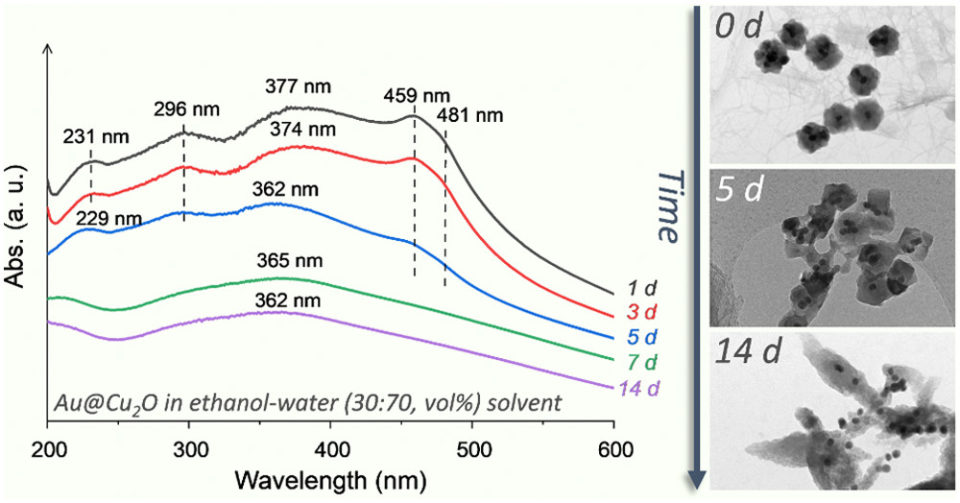
Abstract: Metal@semiconductor core-shell nanoparticles (NPs) are widely used in photocatalysts, sensors and optical applications thanks to the unique metal-semiconductor interface and integration of the properties from both core and shell materials. Although many efforts have been paid on the precise synthesis of Au@Cu2O core-shell structures, the chemical stability of Au@Cu2O aqueous suspensions are not mentioned in any published research, which is of great significance in many related applications. Herein, we report the synthesis of Au@Cu2O core-shell NPs with small shell thickness from 2 to 40 nm through a wet-chemistry method. The UV-Vis absorption properties are found to be tunable with Cu2O thickness in the range of 2~40 nm. Furthermore, the chemical stability of Au@Cu2O core-shell nanoparticle suspensions in ethanol-water mixed solvents are investigated. It was found that ethanol-water mixed solvents with high water content are more likely to deteriorate the stability of Au@Cu2O NPs by oxidizing Cu2O to CuO. The results from this work may provide useful information for the preparation of metal@Cu2O water-based suspensions which are expected to be used for the SERS, photocatalyst or photothermal applications.
- Hsin-hui Huang, Takeshi Nagashima, Tetsu Yonezawa, Yasutaka Matsuo, Soon Hock Ng, Saulius Juodkazis, Koji Hatanaka
“Giant enhancement of THz wave emission under double pulse excitation of thin water flow”
Applied Sciences, 10(6), 2031 (2020). (12 pp.)【Open Access】
DOI: 10.3390/app10062031 (Published 17 Mar 2020)Abstract: Simultaneous measurements of THz wave and hard X-ray emission from thin and flat water flow when irradiated by double femtosecond laser pulses (800 nm, 35 fs/transform-limited, 0.5 kHz, delay times up to 15 ns) were carried out. THz wave measurements by time-domain spectroscopy and X-ray detection by Geiger counters were performed at the transmission and the reflection sides of the flow. THz wave emission spectra show their dynamic peak shifts toward the low frequency with the highest intensity enhancements more than 1.5×103 times in |E|2 accumulated over the whole spectrum range of 0–3 THz at the delay time of 4.7 ns between the two pulses. On the other hand, X-ray intensity enhancements are limited to about 20 times at 0 ns under the same experimental conditions. The mechanisms for the spectral changes and the intensity enhancements in THz wave emission are discussed from the viewpoint of laser ablation on the water flow induced by the pre-pulse irradiation.
- Lianlian Deng, Mai Thanh Nguyen, Jinming Shi, Yuen-ting Rachel Chau, Tomoharu Tokunaga, Masaki Kudo, Syo Matsumura, Naoyuki Hashimoto, and Tetsu Yonezawa*
“Highly Correlated Size and Composition of Pt/Au Alloy Nanoparticles via Magnetron Sputtering onto Liquid”
Langmuir, 36(12), 3004-3015 (2020).
DOI: 10.1021/acs.langmuir.0c00152 (Published (web) 9 Mar 2020)

Abstract: Pt/Au alloy nanoparticles (NPs) in a wide composition range have been synthesized by room-temperature simultaneous sputter deposition from two independent magnetron sources onto liquid PEG (MW = 600). The prepared NPs were alloy with the face-centered cubic (fcc) structure. In addition, particle sizes, composition, and shape are strongly correlated but can be tailored by appropriate variation of sputtering parameters. No individual particle but large agglomerates with partially alloy structure formed at Pt content less than 16 at.%. Highly dispersed NPs with no agglomeration were observed in PEG when Pt atomic percentage is more than 26 at.%. On the other hand, a small amount of Pt could terminate the agglomeration of Au when sputtering on the grids for transmission electron microscope observation. Our experiment as well as computer simulation carried out by two different methods indicate that the composition-dependent particle size of Pt/Au can be explained by the atomic concentration, formation energy of cluster, and the interaction between different metal atoms and PEG molecule.
- Hsin-Hui Huang, Yuen-ting Rachel Chau, Tetsu Yonezawa,* Mai Thanh Nguyen, Shilei Zhu, Dan Deng, Takeshi Nagashima, Koji Hatanaka*
“THz Wave Emission From ZnTe Nano-Colloidal Aqueous Dispersion Irradiated by Femtosecond Laser”
Chemistry Letters, 49(6), 597-600 (2020).
DOI: 10.1246/cl.200055 (Published (web) 12 Mar 2020)

Abstract: THz wave emission from ZnTe nano-colloidal aqueous dispersion flow (the particle size is 5-nm in diameter, the flow thickness is 17 μm) with two different particle densities (1.60 mmol/L and 1.07 mmol/L) was measured by time-domain spectroscopy (TDS) under femtosecond laser irradiation (>35 fs/transform-limited, 800 nm, horizontally-polarized, 0.5 kHz) in air. Intensity increase and peak shift in the TDS signal wave-form if compared with distilled water indicate that THz wave emission is induced in ZnTe nano-particles in the aqueous dispersion.
- Ikumi Akita, Yohei Ishida, and Tetsu Yonezawa
“COUNTING THE LAYER NUMBER OF FREE-STANDING MONTMORILLONITE NANOSHEETS USING ANNULAR DARK FIELD SCANNING TRANSMISSION ELECTRON MICROSCOPY”
Clay Science, 21(3), 41-45 (2019).【Open Access】
DOI: 10.11362/jcssjclayscience.23.3_41 (Published 1 Mar 2020)Abstract: In this report, we demonstrate the direct determination of the layer number of free-standing montmorillonite (MMT) nanosheets using annular dark field (ADF) scanning transmission electron microscopy (STEM). The layer number of the free-standing MMT nanosheets deposited on a holey carbon-coated grid was successfully counted to range from monolayer to four layers by the difference in the ADF contrast. Meanwhile, counting of the layer numbers was difficult using conventional TEM and bright field STEM due to the low contrast. Therefore, ADF–STEM can potentially be applied to further investigate the clay nanosheets and their molecular complexes by the atomic scale imaging for a deeper understanding of clay-nanosheet-based chemistry.
- Yuen-ting Rachel Chau, Mai Thanh Nguyen, Mingbei Zhu, Arnaud Romier, Tomoharu Tokunaga, and Tetsu Yonezawa*
“Synthesis of compositional tunable Pd-Cu alloy nanoparticles by double target sputtering”
New Journal of Chemistry, 44(12), 4704-4712 (2020).
DOI: 10.1039/D0NJ00288G (Published (web) 5 Feb 2020)
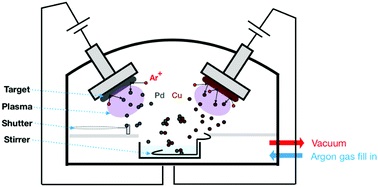
Abstract: In this work, we introduce a green synthesis technique, double-target sputtering into a liquid polymer – polyethylene glycol (PEG, M. W. = 600), to synthesize palladium-copper (Pd-Cu) alloy nanoparticles (NPs) dispersed in PEG. The composition of Pd and Cu in the alloy NPs can be controlled and varied by applying different sputtering currents for Pd and Cu targets. The particle sizes of Pd-Cu NPs are maintained in the range of 2.3-2.4 nm for various Pd-Cu compositions. Oxidation issues and crystallinity enhancement are discussed.
裏表紙採用,Cover illustration is also published.
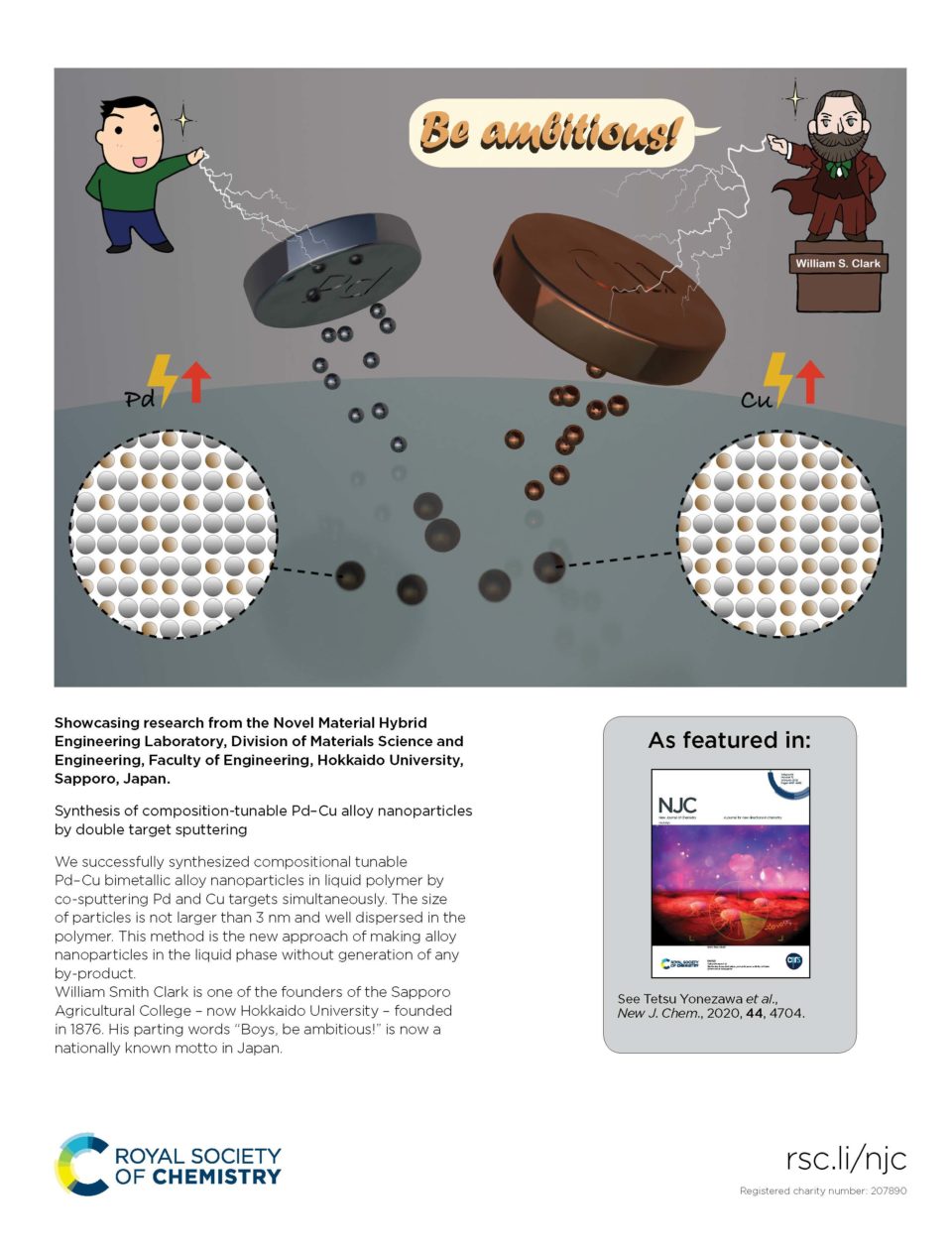
- Shilei Zhu, Mai Thanh Nguyen, Tomoharu Tokunaga, Cheng-Yen Wen, and Tetsu Yonezawa*
“In situ TEM observation of liquid-state Sn nanoparticles vanishing in SiO2 structure: a potential synthetic tool for controllable morphologies from core-shell to yolk-shell and hollow structures”
Nanoscale Advances, 2(4), 1456-1464 (2020).【Open Access】
DOI: 10.1039/C9NA00782B (Publsihed (web) on 3 Feb 2020)
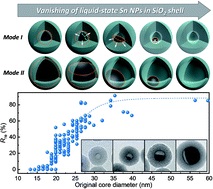
Abstract: Precise design of hollow nanostructure can be realized via various approaches that developed in last two decades, endowing the nanomaterials with unique structures and outstanding performances, showing their talents in a broad range of fields. Herein, we demonstrate the formation of SnO2@SiO2 hollow nanostructures, for the first time, by interaction between liquid state Sn cores and SiO2 shell structure inside Sn@SiO2 core-shell nanoparticles with real-time observation via in situ transmission electron microscopy (TEM). Based on the in situ results, a designed transformation of nanoparticle structure from core-shell Sn@SiO2 to yolk-shell Sn@SiO2 and hollow SnO2@SiO2 is demonstrated, showing the controllable structure from core-shell Sn@SiO2 nanoparticles via fixing liquid state Sn inside SiO2 shell which has a certain Sn containing capacity. The present approach expands the toolbox for the design and preparation of yolk-shell and hollow nanostructure, thus provides us a new strategy in fabrication of more complicated nanostructures.
- Laksanaporn Poolnapol, Wathanyu Kao-ian, Anongnat Somwangthanaroj, Falko Mahlendorf, Mai Thanh Nguyen, Tetsu Yonezawa, and Soorathep Kheawhom
“Silver Decorated Reduced Graphene Oxide as Electrocatalyst for Zinc–Air Batteries”
Energies, 13(2), 462 (2020). 【Open Access】
DOI:10.3390/en13020462 (Published on 17 January 2020)Abstract: Due to their low cost and very high energy density, zinc–air batteries (ZABs) exhibit high potential for various energy applications. The electrochemical performance of the air-cathode has a decisive impact on the discharge performance of ZABs because the sluggish oxygen reduction reaction (ORR) kinetics increase the overpotential of the air-cathode and hence the performance of ZABs. In this work, reduced graphene oxide decorated with silver nanoparticles (AgNP/rGO) is synthesized using simultaneous reduction of graphene oxide and silver ions. Different amounts of silver loading are examined for the synthesis of AgNP/rGO. The synthesized AgNP/rGO samples are analyzed using a rotating disk electrode in order to investigate ORR activity. Then, the synthesized AgNP/rGO electrocatalyst is applied on a tubular designed zinc–air battery in order to study the performance of the zinc–air battery. Results demonstrate that AgNP/rGO is an efficient and cost-effective ORR electrocatalyst for its practical application in ZABs.
Review Papers in Japanese
- 米澤 徹
「マイクロ波液中プラズマによるナノ粒子の合成とその応用」
触媒、(2020)(印刷中)
(特集:次世代の触媒プロセスを支えるマイクロ波) - 米澤 徹
「濃厚分散系としての導電インク・ペーストの作製ならびに微細構造検証」【総説】
日本接着学会誌,56(5), (2020).(印刷中) - 松原正樹・蟹江澄志・米澤 徹
「高分子修飾微粒子・ナノ粒子の熱的構造制御」
材料表面,5(1), 11-17 (2020).
Masaki Matsubara,* KIyoshi Kanie, and Tetsu Yonezawa
“Thermal Structure Control of Polymer-Modified Fine Particles and Nanoparticles”
Accounts of Materials & Science Research, 5(1), 11-17 (2020).
Link (Published (web) 30 Jan 2020)
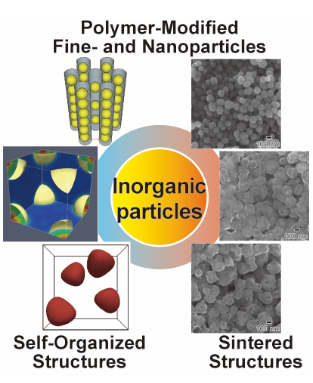
Abstract: Polymer-modified inorganic fine particles and nanoparticles have a great possibility of developing synergistic functions that cannot be achieved with inorganic materials and organic materials themselves, because polymers exhibit thermally unique behavior. We have focused on these unique thermal behaviors of polymers and designed chemical structures of polymers in terms of the functions required for hybrid materials. In this account paper, low-temperature sintering and sintered structure of Cu fine particles and temperature-dependent self-organized structure of organic-inorganic dendrimers are briefly reviewed. A new preparation method of polymer-modified fine particles by SI-ATRP will also be discussed.
